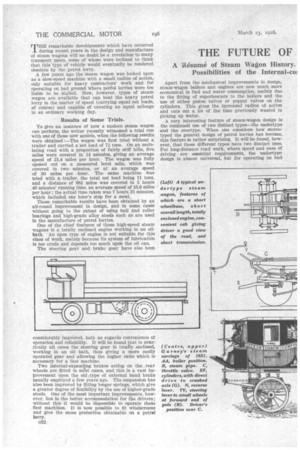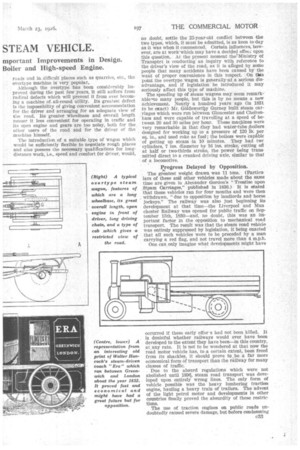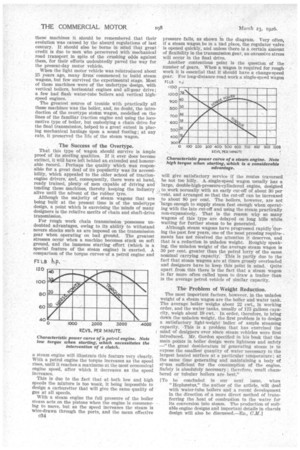THE FUTURE OF STEAM VEHICLE.
Page 20

Page 21

Page 22

If you've noticed an error in this article please click here to report it so we can fix it.
TE remarkable developments which have occurred during recent years in the design and manufacture of steam wagons will no doubt be a revelation to many transport users, some of whom were inclined to think that this type of vehicle would eventually be rendered obsolete by the petrol lorry.
A few years ago the steam wagon was looked upon as a slow-speed machine with a small radius of action, only suitable for heavy contractors' work and for operating on bad ground where petrol lorries were too liable to be stalled. Now, however, types of steam wagon are available that can beat the heavy petrol lorry in the matter of speed (carrying equal net loads, of course) and capable of covering an equal mileage in an ordinary working day.
Results of Some Trials.
To give an instance of how a modern steam wagon can perform, the writer recently witnessed a trial run with one of these new models, when the following results were obtained :—The wagon was first tried without a trailer and carried a net load of 71 tons. On an undulating road with a proportion of fairly stiff hills, five miles were covered in 14 minutes, giving an average speed of 21.4 miles per hour. The wagon was fully opened out on a measured level mile, which was covered in two minutes, or at an average speed of 30 miles per hour. The same machine Was tried with a trailer, the total net load being 11 tons, and a distance of 88-i miles was covered in 5 hours 40 minutes' running time, an average speed of 15.6 miles per hour ; the actual time taken was 7 hours .25 minutes, which included one hour's stop for a meal.
These remarkable results have been obtained by an all-round improvement in design, and in some cases without going to the extent of using ball and roller bearings and Ifigh-grade alloy steels such as are used in the manufacture of petrol lorries.
One of the chief features of these high-speed steam wagons is a totally enclosed engine working in an oilbath. An open type of engine is not suitable for this class of work, mainly because its system of lubrication is too crude and depends too much upon the oil can.
The steering gear and brake gear have also been
considerably improved, both as regards convenience of operation and reliability. It will be found that in practically all cases the steering gear is totally enclosed, working in an oil bath, thus giving a more easily operated gear and allowing the higher rabio which is necessary for a fast machine.
Two internal-expanding brakes acting on the.. rear 'wheels are fitted in most cases, and this is a vast improvement upon the old ?type of external band brake usually employed a few years ago. The suspension has also been improved by fitting longer springs, which give a greater degree of flexibility by the use of higher-grade steels. One of the most important improvements, however, lies in the better accommodation for the drivers ; without this it would be impossible to operate thee fast machines. It is now possible to fit windscreens and give the same protection obtainable on a petrel Lorry.
c32 Apart from the mechanical improvements in design, steam-wagon boilers and engines are now much more economical in fuel and water consumption, mainly due to the fitting of superheaters to the boilers and the use of either piston valves or poppet valves on the cylinders. This gives the increased radius of action and cuts out a lot of the time previously wasted in picking up water.
A very interesting feature of steam-wagon design is the continued use of two distinct types—the undentype and the overtype. When one considers how stereotyped the general design of petrol lorries has become, this feature is rather surprising. It will be found, however, that these different types have two distinct uses. For long-distance road work, where speed and ease of driving are essential requirements, the -undertype design is almost universal, but for operating on bad
roads and in. difficult places such as quarries, etc., the • overtype machine is very popular..
Although the oventype has been considerably improved during the past few years, it still suffers from radical defects which will prevent it from ever becoming a machine of. all-round utility. Its greatest defect • Is the impossibility of giving convenient accommodation for the driver and arranging fOr an adequate view of • the road. Its greater wheelbase and overall length mailer it less convenient for operating in traffic .and its open engine and gears are too noisy, both for the other users of the road and for the driver of the • machine himself.
The introduction of a suitable type of wagon which Would be sufficiently flexible to negotiate rough places and also possess the necessary qualifications for longdistance work, i.e., speed, and comfort for driver, would,
no doubt, settle the 25-year-old conflict between the two types, which, it must be admitted, is as keen to day as it was when it commenced. Certain influences, however, are at work-which may have a decided effee,; upon this question. At the present moment the'Ministry of Transport is conducting an inquiry with reference to the driver's view of the road, as it is alleged by some people that many accidents have been caused by the want of proper convenience in this respect. On this point the oventype wagon is generally at a serious disadvantage, and if legislation be introduced it may seriously affect this type of machine.
The speeding up of steam wagons may seem remark-able%to many people, but this is by no means a new achievement. Nearly a hundred years ago (in 1831 to be exact) Mr. Gbldswortlity Gurney built steam carriages which were run between Gloucester and Cheltenham and were capable of travelling at a speed of between 20 and 30 miles per hour. These machines were very remarkable in that they had water-tube boilers designed for working up to a pressure of 1201b per sq. in., and used coke as fuel; the boilers were -caph.bic of getting up steam in 10 minutes. They had twc cylinders, 7 ins, diameter by 16 ins, stroke, cutting oil at half or two-thirds stroke, the power being transmitted direct to a cranked driving axle, similar to that of a locomotive.
Progress Delayed by Opposition.
The greatest weight drawn was 11 tons. (Particulars of these slid other vehicles made about the same time are given in Alexander Gordon's 'Treatise upon .Stpam Carriages," published in 1836.) It Is stated that these vehicles ran for four months and were then withdrawn, "due to opposition by landlords and -horse jockeys." The railway was also just beginning its development at that time—the Liverpool and Man chester Railway was opened for public traffic on September 15th, 1830—and, no doubt, this was an important factor in the opposition to raechanical road transport. The result was that the steam road vehicle was entirely suppressed by legislation, it being enacted that all such vehicles were to be preceded by a man carrying a red flag, and not travel more than 4 m.p.h.
One can only imagine what developments might have
occurred if these early effor-s had not been killed. It is doubtful whether railways would ever have been developed to the extent they have been—in this country, at any rate. It is not to be wondered at that now the road motor vehicle has, to a certain extent, been freed from its shackles, it should prove to be a far more .economical form of transport than the railway for many classes of traffic.
Due to the absurd regulations which were not abolished until 189% steam road transport was developed upon entirely wrong lines. The only form of vehicle possible was the heavy lumbering traction engine, hauling a heavy train of trailers. The advent Of the light petrol motor and developments in other countries finally proved the absurdity of these restrictions.
The use of traction engines on public roads undoubtedly caused severe damage, but before condemning 033 these machines it should be remembered that their evolution was caused by the absurd regulations of last century. It should also be borne in mind that great credit is due to men who persevered with mechanical road transport in spite of the crushing odds against them, for their efforts undoubtedly paved the way for the present-day motor vehicle.
When the light motor vehicle was reintroduced about 25 years ago, many firms commenced to build steam wagons, but few survived the experimental stage. Most of these machines were of the undertype design, with vertical boilers, horizontal engines and all-gear drive; a few had flash water-tube boilers and vertical highspeed engines.
The greatest source of trouble with practically all these machines was the boiler, and, no doubt, the introduction of the overtype steam wagon, modelled on the lines of the familiar traction engine and using the locomotive type of boiler, but embodying a chain drive for the final transmission, helped to a great extent in placing mechanical haulage upon a sound footing; at any rate, it preserved the life of the steam wagon.
The Success of the Overtype.
That this type of wagon should survive is ample proof of its sterling qualities. If it ever does become extinct, it will have left behind an extended and honourable record. Perhaps the quality which was responsible for a great deal of its popularity was its accessibility, which appealed to the older school of tractionengine drivers, and, consequently, there were at hand, ready trained, plenty of men capable of driving and tending these machines, thereby keeping the industry alive until the advent of the rubber tyre.
Although the majority of steam wagons that are being built at the present time is of the undertype design, a point which is exercising the minds of many designers is the relative merits of chain and shaft-drive transmission.
For rough work chain transmission possesses undoubted advantages, owing to Its ability to withstand severe shocks such as are imposed on the transmission gear when operating on bad ground. The greatest stresses occur when a machine becomes stuck on soft ground, and the immense starting effort (which is a special feature of the steam engine) is exerted. A comparison of the torque curves-of a petrol engine and a steam engine will illustrate this feature very clearly. With a petrol engine the torque increases as the speed rises, until it reaches a maximum at the most economical engine speed, after which it decreases as the speed increases.
This is due to the fact that at both low and high speeds the mixture is too weak, it being impossible to design a carburetter that will give the same quality of gas at all speeds.
With a steam engine the full pressure of the boiler steam acts on the pistons when the engine is commencing to move, but as the speed increases the steam is wire-drawn through the ports, and the mean effective pressure falls, as shown in the diagram. Very often, if a steam wagon be in a bad place, the regulator valve is opened quickly, and unless there is a certain amount of flexibility in the transmission gear, an excessive stress will occur in the final drive.
Another contentious point is the question of the number of gears. When a wagon is required for rough work it is essential that it should have a change-speed gear. For long-distance road work a single-speed wagon nae e.,: will give satisfactory service if the routes traversed be not too hilly. A single-speed wagon usually has a large, double-high-pressure-cylindered engine, designed ; to work normally with an early cut-off of about 30 per '!cent. and arranged so that the cut-off can be increased 'large enough to supply steam fast enough when operatto about 80 per cent. The boilers, however, are not ing with the late cut-off and using the steam practically non-expansively. That is the reason why so many wagons of this type are delayed on long hills while waiting for further steam to be generated.
Although steam wagons have progressed rapidly {during the past few years, one of the most pressing requirements has not received the attention it deserves, and that is a reduction in unladen weight. Roughly speaking, the unladen weight of the average steam wagon is 50 per cent. greater than the petrol lorry of the same nominal carrying capacity. This is partly due to the fact that steam wagons are at times grossly overloaded and designers have to keep this point in mind. Quite apart from this there is the fact that a steam wagon is far more often called upon to draw a trailer than is the average petrol vehicle of similar capacity.
The Problem of Weight Reduction.
The most important factors, however, in the unladen weight of a steam wagon are the boiler and water tank. The average boiler weighs about 22 cwt., in working order, and the water tanks, usually of 175 gallons capacity, weigh about 19 cwt.'• in order, therefore, to bring down the unladen weight, the first problem is to design a satisfactory light-weight boiler of ample steaming capacity. This is a problem that has exercised the mind of designers -ever since steam vehicles were first introduced. Mr. Gordon specified in his book that the main points in holler design were lightness and safety —" the great desideratum in generating steam is to expose the smallest quantity of water necessary to the largest heated surface at a particular temperature; at the same time generating and maintaining a body of steam sufficient for the consumption of the engine. Safety is absolutely necessary ; therefore; small chambered or tubular boilers are best."
To be concluded in our next issue, when " Hephwstus," the author of the article, will deal with Water-tube boilers and a recent development in the direction of a more direct method of transferring the heat of combustion to the water for its conversion into steam. The production of suitable engine designs and important details in chassis design will also be discussed.—En., C.M.]
































